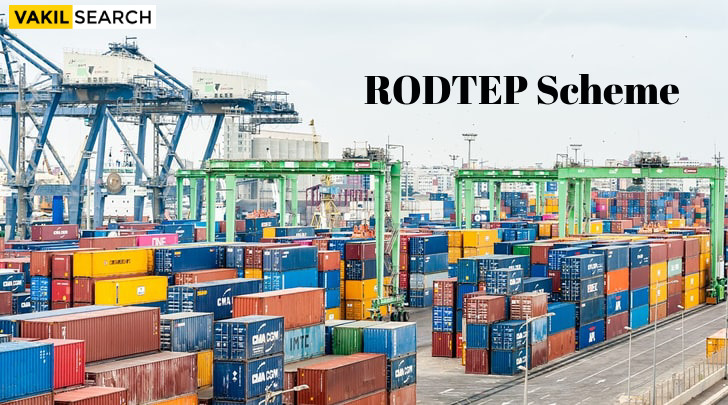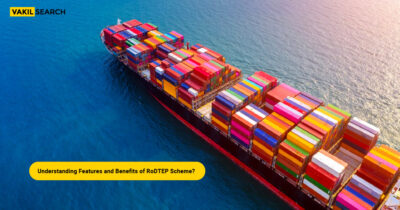The full form for the RoDTEP scheme is the Remission of Duties and Taxes on Export Products. This comparatively new scheme was launched around 2021 to fully replace the MEIS or the Merchandise Exports from India Scheme.
Introduction
RoDTEP Scheme stands for Remission of Duties and Taxes on Export Products. It is a new system that will go into effect on January 1, 2021. It replaced the existing MEIS (Merchandise Exports from India Scheme). The scheme ensures that the exporters receive the refunds on the embedded taxes and duties previously non-recoverable. It was implemented with the purpose of increasing exports, which had previously been rather low in volume.
This is a new scheme aimed at the benefit of the exporters so that they receive all kinds of relevant refunds applicable on embedded taxes and all duties that could not previously be recovered. In India, this RODTEP Scheme is mainly directed toward the betterment and development of exports, especially those export sectors which were poor performers initially for a long time.
What Is RoDTEP?
The Indian government made a new plan called RoDTEP in 2020 to help Exporters. The plan offers various tax relaxations to the exporters. This helps them compete with other sellers from around the world. The RoDTEP plan started on 1 January 2021, and replaced an older plan like MEIS. As per the scheme the exporters will receive funds on the embedded taxes and duties that were non recoverable previously.
Significance of RoDTEP
RODTEP Scheme is designed to ensure complete refund of Central and state taxes on fuel used for export transportations. Previously under the MEIS, certain tax and duties such as VAT on fuel used in transportation of goods was not refunded. RoDTEP is a fully automatic digital credit system having an inbuilt risk management software to facilitate various reimbursements of taxes and duties. This scheme covers all the industries including textiles.
Features of RODTEP Scheme
Refund of Previously Non-Refundable Duties and Taxes:
The RoDTEP Scheme allows for the refund of duties and taxes that were previously non-refundable. This includes Mandi tax, VAT, Coal cess, Central Excise duty on fuel, and other items previously covered under MEIS and RoSTCL.
Automated System of Credit:
Refunds under RoDTEP will be issued in the form of transferable electronic scrips. These duty credits will be managed and monitored through an electronic ledger.
Quick Verification through Digitisation:
The introduction of a digital platform expedites the clearance process. The records of exporters will undergo verification using an IT-based risk management system, ensuring both speed and accuracy in transaction processing.
Multi-Sector Scheme:
RoDTEP encompasses all sectors, including textiles, to ensure consistency across various industries. A dedicated committee will be established to determine the phased introduction of the scheme across sectors and the extent of benefits to be provided to each sector.
Eligibility for RODTEP Scheme
- All sectors, including textiles, are eligible for RoDTEP benefits. Priority will be given to labour-intensive sectors benefiting from the MEIS Scheme.
- Both manufacturer exporters and merchant exporters (traders) can avail themselves of the scheme’s benefits.
- There is no specific turnover threshold required to claim RoDTEP.
- Re-exported products are not eligible under this scheme.
- To qualify for RoDTEP benefits, exported products must have India as the country of origin.
- Special Economic Zone Units and Export Oriented Units are eligible for benefits under this scheme.
- Goods exported via courier through e-commerce platforms are also covered under the RoDTEP scheme.
Other Programmes
In addition to the RODTEP Scheme, the government has implemented various other programs aimed at promoting entrepreneurship, financial inclusion, skill development, and affordable housing. These programs include the Prime Minister Employment Generation Programme, PM Jeevan Jyoti Bima Yojana, Jan Dhan Yojana, Deen Dayal Upadhyaya Grameen Kaushalya Yojana, and Pradhan Mantri Awas Yojana.
Objectives of RODTEP Scheme
The RoDTEP (Remission of Duties and Taxes on Exported Products) Scheme has been designed with several key objectives aimed at bolstering the export sector, particularly addressing issues related to volume and ease of doing business. The main objectives include:
Boosting Export Sector:
The primary objective of the RoDTEP Scheme is to provide a significant impetus to the export sector, fostering growth and competitiveness in the global market.
Facilitating Easy Refunds:
The scheme aims to streamline and expedite the process of obtaining refunds for various taxes incurred by exporters. This is intended to enhance the liquidity of exporters and make the export process more financially viable.
Reducing Cascading Effect of Taxes:
By establishing an automatic refund mechanism, the RoDTEP Scheme seeks to eliminate the cascading effect of taxes, commonly known as tax on tax. This helps in creating a more transparent and efficient taxation system for exporters.
Improving International Standards:
Another key objective is to assist exporters in meeting international standards. The scheme encourages the enhancement of the quality of exports, making Indian products more competitive and acceptable in the global market.
Inclusion of Previously Excluded Taxes:
The RoDTEP Scheme aims to be more comprehensive by including taxes that were previously excluded. This includes taxes like education cess, as well as state taxes on power, oil, and water. The inclusion of these taxes ensures a more accurate representation of the overall tax burden on exporters.
Addressing Exclusions:
The scheme aims to rectify any gaps or exclusions in the previous tax refund systems, ensuring that a wider range of taxes are considered for reimbursement. This contributes to a fair and inclusive framework for exporters.
By addressing these aspects, the scheme strives to create a more conducive environment for Indian exports in the global marketplace.
Why Was RoDTEP Scheme Introduced in Place of Other Programmes?
Some of the programs that were withdrawn included the merchandise exports from India scheme, the export-oriented units scheme, the electronics hardware technology parks scheme, the biotechnology park scheme, the export promotion capital goods scheme, the special economic zone scheme and lastly, the scheme that was aimed at the duty-free imports only targeted for the exporters.
Need for the RoDTEP Scheme
There is, of course, a need for the RoDTEP scheme. In the past, regarding the subsidized export schemes from India, the United States of America challenged the World Trade Organization. They claimed that the Indian versions of the subsidized schemes were harming their American counterparts.
There was also a dispute panel constructed where the WTO gave decisions against India and told that India was violating some of the trade norms. And as a result, all the export subsidy programs that India had, were nullified and dissolved, and then came the RoDTEP scheme, which was completely per the regulations put forward by the WTO
Some of the export subsidy programmes considered for withdrawal include:
- Merchandise Exports from India Scheme
- Export Oriented Units Scheme
- Electronics Hardware Technology Parks Scheme
- Bio-Technology Parks Scheme
- Export Promotion Capital Goods Scheme
- Special Economic Zones (SEZ) Scheme
- Duty-Free Imports for Exporters Scheme
What Are the Benefits of RoDTEP?
- Increases Competitiveness:
The businesses receiving tax reimbursement will have better scope to sell their products cheaper. This will increase exports and promote a healthy competition between the Indian exporters. This will also provide a better advantage for Indian exporters on the international front.
- Cost Savings:
Undoubtedly, the exporters can save a lot of taxes and extra fees under the scheme. This will make it easier and cheaper for them to sell things outside of India.
- Improved Profitability:
The RoDTEP can help exporters to make better profit by providing reimbursement. This can then help them grow their business by investing in new ideas and expanding what they offer.
- Encourages Export Promotion:
Encourages Indian exporters to export their goods to multiple countries. The scheme also provides various incentive.
What Are the Features of the RoDTEP Scheme?
Some of the major features of the RoDTEP scheme are enumerated as under:
-
Refund of the Previously Non-refundable Duties and Taxes
Now, there is a provision for the refunding of all those taxes and duties that were erstwhile regarded as non-refundable. The Mandi tax, VAT, Coal cess, the central excise duties on fuel, etc. All these now have a provision to be refunded, and all those items considered to be a part of the MEIS and the Rebate of State and Central Taxes and Levies now fall under the category of the RoDTEP scheme
-
Automated System of Credit
Along with that, now there is an advantage of an automated credit system. What does this imply? The whole refund can now be issued as electronic scrips that are easily transferable. These duty credits are always easily maintained with the help of an electronic ledger
-
Quick Verification Through Digitization
There is also a process of very quick verification that can be done with the help of digitisation. All the verifiable data from the major Indian exporters can be stored in an advanced digital system
-
Multi-Sector Scheme
There is also the inclusion of a multi-sector scheme that can ensure a uniform business throughout. An active committee takes care of how to go on with the RoDTEP scheme and ensures that all parties belonging to Import and Export registration where the businesses derive their benefits from this scheme.
Requirements of the RoDTEP Scheme
The RoDTEP allows Indian exporters to reimburse the taxes and fees paid for goods transportation. The following criteria and rules have to be followed for the reimbursement.
- They need to have a special code called Import-Export (IE) code, and they need to make the thing they want to sell in India
- They also need to have made at least ₹2 crores of Indian rupees in one year
- They can’t owe any money to the government, and they need to follow all the rules for selling things outside of India
- They need to fill out some forms to get their money back.
Know About the Eligibility to Get the RoDTEP Scheme
Various sectors want to avail the benefits of the RoDTEP scheme:
- The textile sector and other major sectors can reap the benefits of the scheme. There are also labor-intensive sectors that fall under the category of the MEIS and that will be given significant priority in these cases
- In addition, all the manufacturers and exporters, including merchant exporters and small and large-scale traders, can also enlist themselves under the scheme. There is no single threshold or structure that one needs to consider while claiming the scheme’s benefits of the scheme ● Additionally, one bar is that those products re-exported are not eligible to fall under this scheme. To suit the rule of eligibility, the exported products MUST have India as the country of their origin and manufacturing
- If there are the SEZ or the Special Economic Zones, and the Export Oriented Units, they are also categorized under the eligible sector to reap the benefits of the RoDTEP scheme
- Apart from this, if some of the goods are exported with the help of a courier service through e-commerce portals, and online selling platforms, the also RoDTEP scheme is active under this criterion.
Procedure to Apply for RoDTEP Scheme Online
- Step 1: Visit the official website of the Directorate General of Foreign Trade (DGFT) at https://dgft.gov.in
- Step 2: Click on the ‘Services’ tab on the homepage and select ‘RoDTEP’ from the dropdown menu
- Step 3: Next, click on ‘Apply for RoDTEP’ and enter your Import-Export (IE) code and password to log in to the portal
- Step 4: Select the relevant shipping bill or bill of export for which you wish to claim RoDTEP benefits
- Step 5: provide all the relevant information
- Step 6: Upload the necessary documents
- Step 7: Review the application form and ensure that all details provided are correct
- Step 8: Submit the application online
- Step 9 : After submission, you will receive an acknowledgement with a reference number. Keep this reference number for future reference
- Step 10 : based on the claim and post verification the amount will be credited to the bank account
Procedure to Issue Duty Credit for Goods Exported Under the RoDTEP Scheme
Exporters who can avail benefits under the RoDTEP scheme must apply for the duty credit by submitting their claim on the online portal of the Directorate General of Foreign Trade (DGFT).
- Go to the DGFT online portal
- Provide information about the export shipment, including date, name, product details, export shipment value, and duty paid
- Submit supporting documents like invoices, shipping bills, and export declarations
- Confirm eligibility for RoDTEP benefits with a declaration
- Wait for DGFT to review the claim and documents submitted.
Difference Between MEIS and Rodtep
| Aspect | MEIS | RoDTEP |
| Objectives | To provide duty credit scrips as incentives to offset taxes and duties paid by exporters | To reimburse exporters for taxes and duties paid while making and delivering goods |
| Coverage | Covered many different types of products and industries | Covers almost all products and industries except for a few specific items |
| Duration | Ended on 31 December 2020 | Started on 1 January 2021 |
| Benefit Calculation | Incentives were based on a percentage of the value of goods exported | Benefits are based on the taxes and duties paid by exporters during the production and distribution of goods |
| Reimbursement Process | Exporters were given special certificates to use for paying taxes and fees | Exporters are directly refunded by putting money in their bank accounts after they apply for it |
Pricing Under the Scheme
A Committee consisting of representatives from the Department of Revenue/Drawback Division, DoC/DGFT, line ministries, and experts will decide on the ceiling rates for sectors prioritized by the Department of Commerce and Department of Revenue. The Ministry of Finance, in consultation with the Department of Commerce (DoC), will determine the overall budget for the RoDTEP Scheme, considering all relevant factors.
Tax Refund Percentage
The RoDTEP scheme offers tax refunds ranging from <0.5>% to <4.3>% based on the sector and product. A detailed breakdown of these rates is provided in Appendix 4 R, and updated rates can be found on the Directorate General of Foreign Trade’s website.
The exporters can get a rebate under the scheme if it falls under certain categories. The rebate will also be based on the percentage of FOB value. There may also be a limit on the amount of rebate per unit of the exported product. For some export commodities, a specific amount of rebate per unit may be announced.
Scheme for Remission of Duties and Taxes on Export Products APPENDIX 4R: Rates of Rebate/Value Cap Per Unit Notification. The government will check and change the RODTEP Scheme rates every year. They will let the exporters know the new rates before the start of the financial year.
Conclusion
Given above are the details related to the application procedures of the RoDTEP Scheme: https://www.dgft.gov.in/CP/?opt=RoDTEP. The Government of our country has brought forward such schemes to benefit the exporters to a large extent. However, if you think you are eligible, we request you go through the given application norms. Explained above are the norms related to an application for the RoDTEP schemes.
As an exporter residing in India, we request you carefully review the guidelines to make a valid application. Documentation is important, and experts state that, possibly, documentation plays a key role in making a valid application in favor of the exporter. It is essential to be noted that an application can be either online or offline, depending on the process-based approach.
Information can be surfed from Government portals if need be, while an exporter needs to define eligibility on various grounds. Professional help can be taken, provided an exporter does not have the required expertise. However, this will require additional expenses as applicable. We suggest that you can get in touch with Vakilsearch, a professional consultancy firm headquartered in Chennai, to help you with making an application.
Read More:








